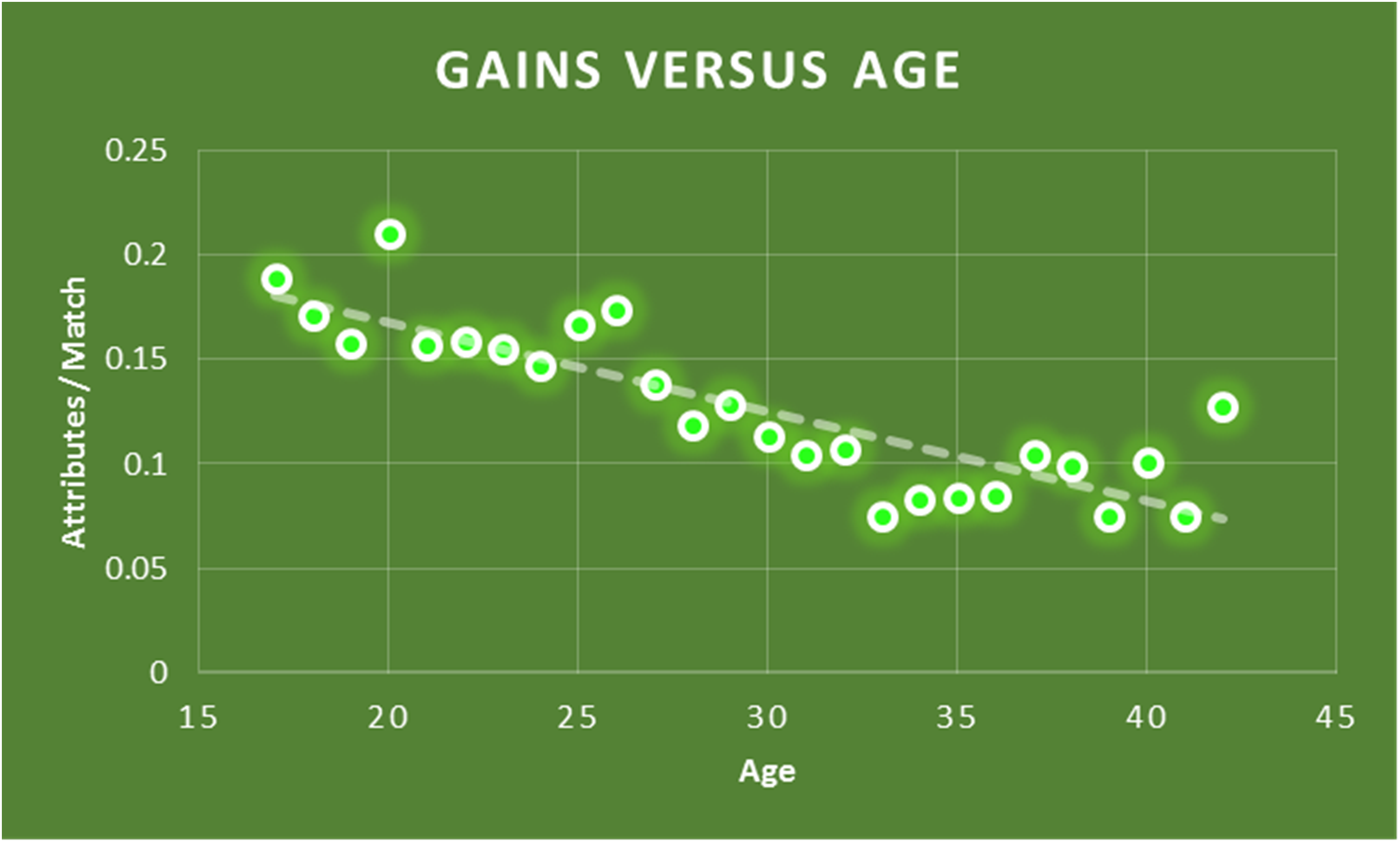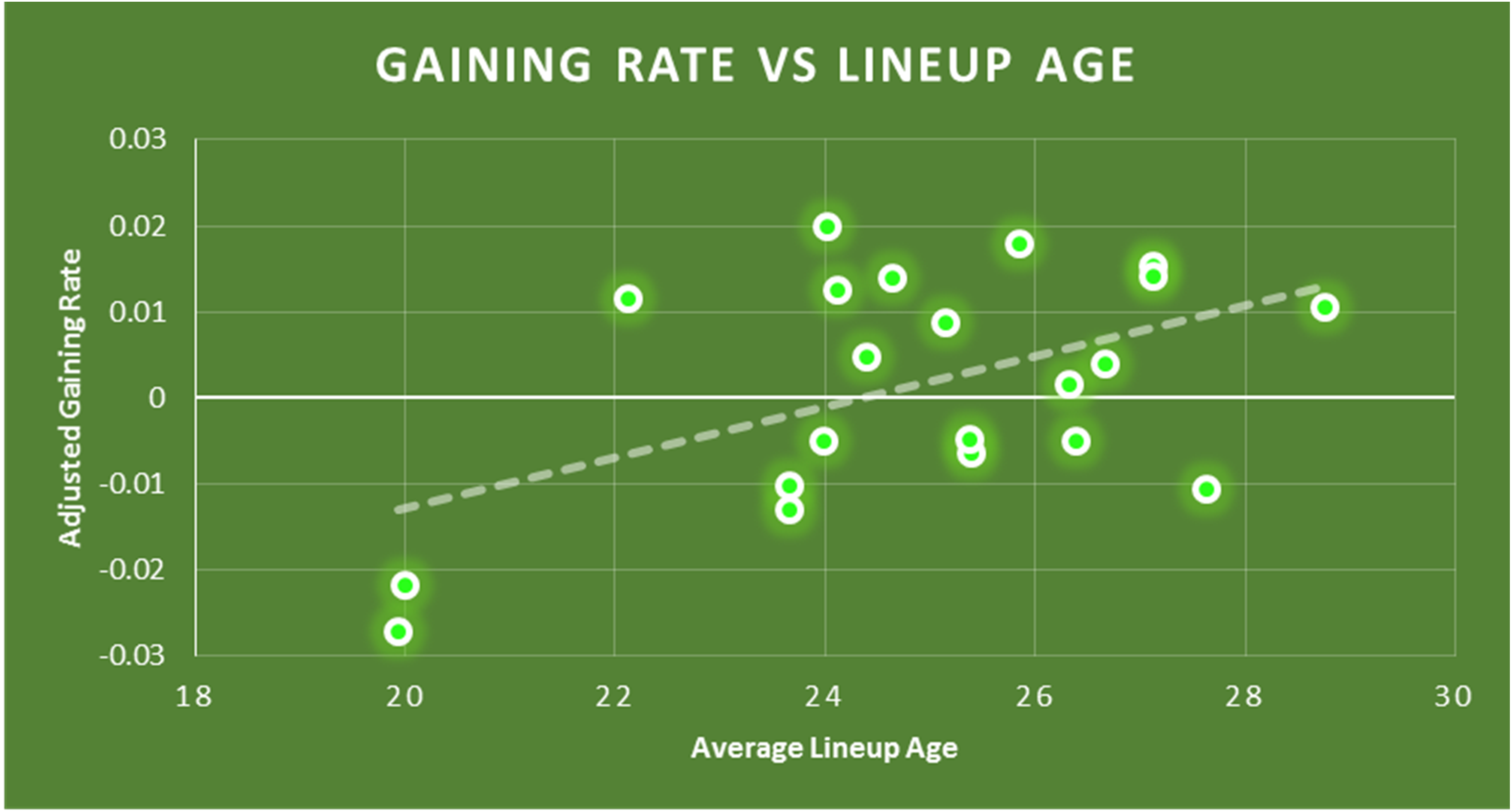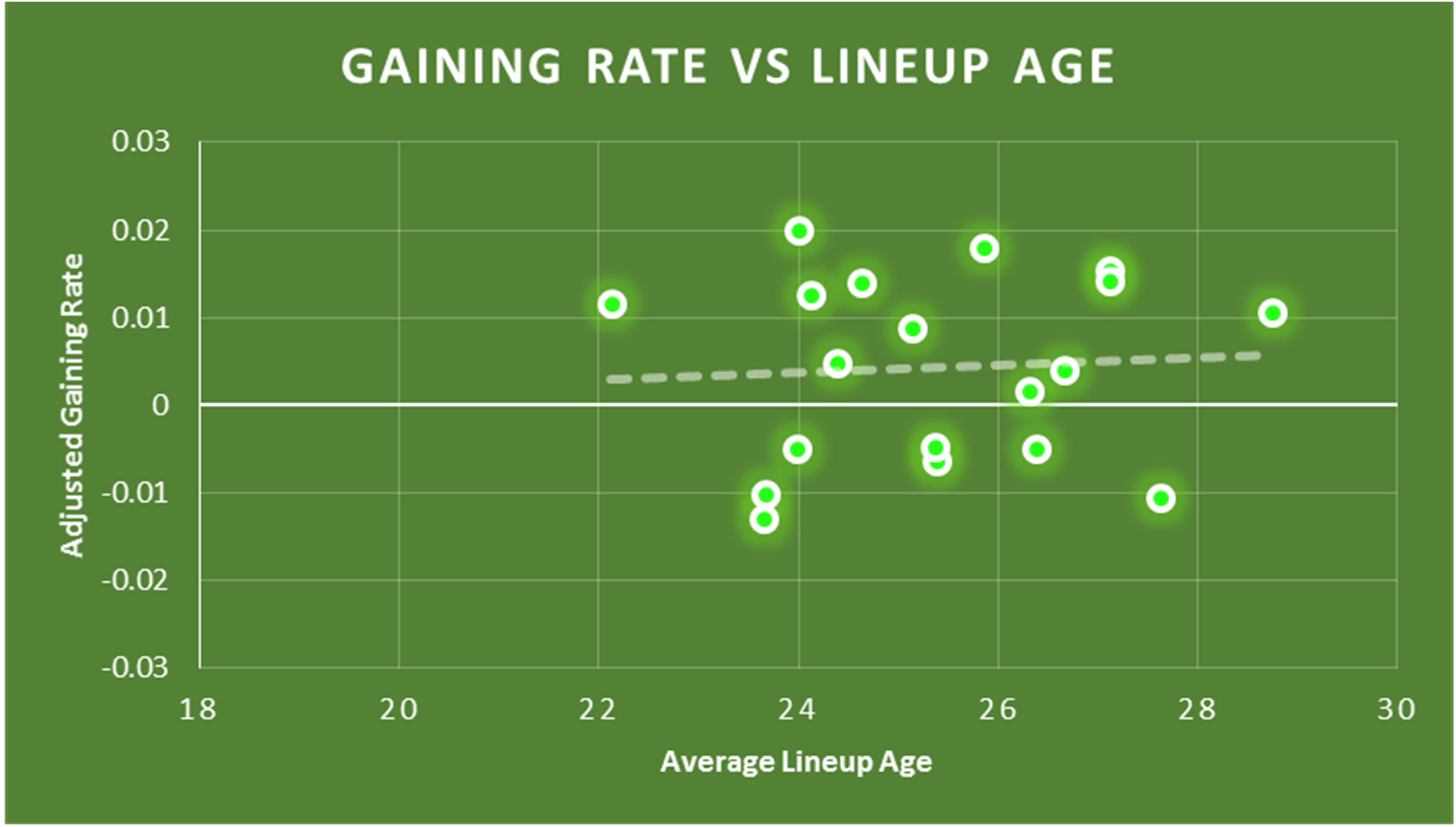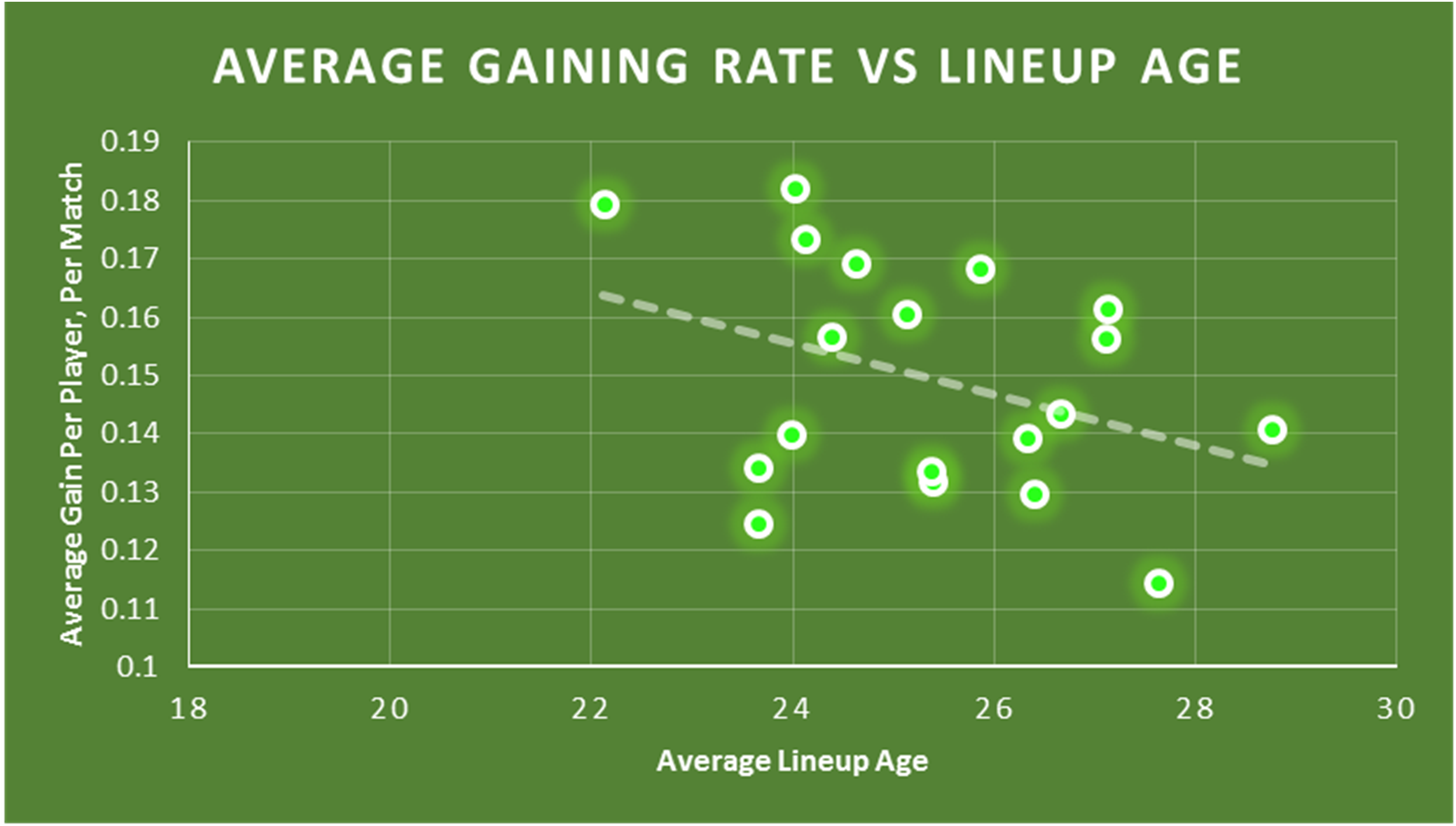| Wonderstar AnalyticsSee all entries in this blog |
Gaining Part 4: Age, Gaining & Data (02/03/2014 04:45) |
"Surrounding young players with older ones probably helps their gains - but perhaps not that much." - Belizio
I'm going to take a diversion from working my way through the list of gaining mantras to go back to the question of how much older players help your younger ones gain (I know you're all desperate to know whether the pumpkin thing is real, don't worry, I haven't forgotten). In a previous post, I wondered whether huge gains on young players were strongly influenced by the age of their teammates, or whether it was mostly just the fact that these young players were getting in close to 200 friendlies a year. I looked at the gaining rate of my own (medium-star, surrounded by all ages) young players, calculated roughly what I could expect from them if I simply made sure they played in as many games as possible, and concluded it was high enough that it probably accounted for most of the gains from "youth farm" teams. That was based at least partly on a gut sense of what a "good" season's gain should look like, so today I'd like to run a quick analysis with a bit more data. As a jumping-off point, here's a nice blog post from (successful Dutch league-and-cup-winning manager) Getzome with a bunch of good advice for those of you who are relatively new to the game. Read it if you haven't already! Midway through the blog though, when discussing player gaining, Getzome stresses one single rule for improving your player gains: "The key to success lies in just one thing: *drumroll drumroll* - Old Players." - Getzome
I think this is exaggerated. I think success lies in a very wide range of factors, just one of which is the surrounding players' ages, and that this factor has less of an effect on gaining than reading most of the guides on the blogs would have you believe. In short, I think it's more possible to balance a competitive squad with decent player gains than is widely assumed. Now just to be clear - my aim is not to suggest that some people are "wrong" for playing the game a certain way, or to pick on any particular guide (I'm just using Getzome's as a jumping-off point because he provides some nice data we can look at, and makes the typical argument that you read in most ManagerLeague guides). Nor am I arguing that age and experience have no effect on gaining. Instead, I see most guides - and therefore a majority of players - adapting identical strategies to build up their teams or cash, and I think this is at least partly because there's a prevailing wisdom that you "have to" do things a certain way if you're going to be competitive. So the aim here is not to tell you that you can't use the 3-young-players-surrounded-by-38-year-olds strategy if you want, but to point out that maybe you don't have to, and that there are legitimate alternative strategies available.
Comparing Strategies To directly compare the effects of different age strategies, I've looked at my own gains for this season, along with Getzome's team (Baronie) and the other nineteen sides making up the current top-20 gainers in the team rankings. That gives us a range of teams who a) are all playing plenty of friendlies and gaining well, and b) are using different strategies. Now, obviously, the total number of gains earned by a team is not that informative on its own - the sides on top will tend to be ones with large squads, younger players, and those who have played lots of friendlies already this season. So, to really see how well each strategy is working I've looked at each team (after S.111 Round 19 but before the weekend cups) and noted the age, number of league games, number of friendlies and total attributes gained for each player on those teams. From this we can get a rough estimate of the number of attributes earned per game for each player*. Here's a plot of how many attributes per match were earned by players of different ages on these teams:
Figure 1: Average number of attributes earned per match for different ages.
Data from 21 strongly gaining teams; Season 111 Rounds 1-19.
Here we can see of course that younger players tend to gain faster than older ones, as we already know. Your youngsters should be getting an attribute for roughly every five or 6 competitive games they play (or roughly every 8-10 friendlies) while your over 30s probably need to play twice as many games for each attribute. The important thing about this is that we can now subtract the appropriate rate from each player's actual attributes/game to see how well they're doing compared to what we'd expect, given their age and the number of games they've played in. Let's call this the Adjusted Gaining Rate. Also, for each team we can figure out the average age of the lineups they actually played (not just the average squad age, but the age of the players on the field), because we know how many matches each of their player appeared in. The average lineup age should be a decent measure of the extent to which that team adopted the "lots of old players" strategy. So, we should see higher Adjusted Gaining Rates per player for older lineups (but lower actual gains, since they're playing fewer young players in friendlies). Which is what we see, albeit with quite a bit of variation:
Figure 2: Adjusted Gaining Rate for lineups of different ages.
That said, there are two teams in this dataset that look a bit different to all the others - the ones in the bottom left corner. Those sides have an average starting lineup of below 20, and have played zero players above the age of 30 this season. They also have pretty terrible gaining rates on their players. That's not to say their teams haven't racked up big gains - they're in the top-20 so far this season - but that's only because they have large squads, filled with young players, and have played most of their friendlies already, and these things are masking the fact that their gains are way below what you would expect from their players. So a pretty solid conclusion you can draw from that is that you're not going to get huge gains on individual players if you surround them with 20-year-olds. OK, let's not do that. But how old do we really need our squad to be? Let's instead look just at the sides with at least some 31+ year-olds in their squad. Suddenly, the pattern isn't quite as conclusive:
Figure 3: Adjusted Gaining Rate for lineups of different ages (but with at least some players over 30).
That's a tiny correlation of just 0.07, way below the size you'd need to be confident there was really an effect. You hear from almost every gaining guide that you should aim for an average lineup age of 28 or more. Now, of the top gaining sides this season, only a couple are getting close to that kind of average age, and with pretty mixed results. So: Although you definitely need at least some older players to get decent gains, there appears to be far less difference between an average age of 22 and one of 28.
Now, (Champion's-League-League-Cup-and-8!!-times-English-League-Champion) Crazy Lion has a very detailed blog post on gaining which you should read. Interestingly, in point 32 Crazy Lion suggests that: "Spinner maintains that having one older player per line will help with gains just as much as filling your squad with older players" - Crazy Lion
I think that leaves open the possibility that older and older squads lead to diminishing returns. It's definitely possible that 3 youngsters surrounded by 38-year-olds will gain slightly better than 5 surrounded by 31-year-olds, but I don't think it is certain. More importantly, if it's true, the size of the boost seems to be quite limited. If you enjoy pouring all your efforts into a very small handful of players each year and striving for the highest gains you can on those guys then go for it! It can't hurt to follow that strategy to its extreme. But if you're more interested in keeping your players, growing organically, and maintaining a competitive squad over a longer time, I think that's also possible. Perhaps it's more of a challenge, but that's why we play the game, right? And your team can always rise again if a strategy you try doesn't work out, so why not mix things up and try doing things a different way? Do whatever makes you enjoy the game most, and don't stress out about following a prescribed route to success! One last thing. When we talk about gaining, we always talk about the effect on a single player - how do we maximise his gains? It's useful to remember that we're always trading off between gains on one player and those on the others, especially with a strategy that fills up most of our squad with older players. Of course it's true that +6Q on three players is better than +3Q on six players, but is it better than +5Q on six players? +5Q on ten players? That's a call you have to make based on your circumstances. So remember, the strongest effect that you see in this dataset is that maximising gain on a few players reduces your gains on everyone else:
Figure 4: Average gains per player, per match, for lineups of different ages.
To put this in perspective, here's a back of the envelope calculation. That difference in Figure 4 means somewhere around 100 extra attributes per season for a team with a few 31-year-olds and an average lineup age 22, compared to a team with average lineup age 28. The boost in adjusted gaining rate for focusing on very few youths, and surrounding them with an old lineup - i.e. the trend in Figure 3 - is worth something like 3-6 attributes per season in total. Getting a single extra attribute onto one of your 6 chosen youth players with this strategy is probably 'costing' something like 20 attributes in lost opportunity for other young players. Something to think about. I hope this post has been interesting, and I'd love to hear what you think in the comments :-) Meanwhile, may your gains be fruitful, whatever strategy you choose!
- Belizio
*Details for those interested: Players can earn through league, cup, player cup or friendly games, plus through normal training and camps, but looking a player's page will only show you how many league and friendly games they played. So I assumed each team played in roughly 4 cup games and 16 player cup games this season, i.e. they won 50% of their knockout matches. Each player was assumed to appear in cups and player cups at the same rate as they appeared in league and friendly games respectively, so a player featuring in 75% of league games and 25% of friendlies was assumed to also have about 3 cup (75% x 4) and 4 player cup (25% x 16) appearances. I assumed every player took part in both of this season's camps, and however many trainings they had fitness available for (for this I assumed stamina of 70-79, losses of 2 fitness per match, and worked out how many trainings they needed to rest in to make the fitness match up over the season so far). I then weighted each type of match and training according to my own data over the previous 3 seasons, i.e. Camps > Matches > Friendlies > Training, with the weight of a competitive match set at 1 - which means all the numbers that follow are "attributes earned per match", but also take into account attributes earned other ways. One attribute per match is roughly equivalent to 0.75 attributes per friendly, 0.45 attributes per training, or 1.9 attributes per camp.
|
| Share on Facebook |
| This blogger owns the team The Wonderstars. (TEAM:154471) |
|
You are currently not logged into ManagerLeague If you wish to log in, click here. If you wish to sign up and join us, click here. |
|
| Zz00874552 wrote: 21:32 15/03 2014 |
|
| Belizio wrote: 00:37 16/03 2014 |
|
| MKManager79 wrote: 14:50 22/05 2014 |
|
| Belizio wrote: 18:05 22/05 2014 |
|
| MKManager79 wrote: 21:51 22/05 2014 |
|
| Belizio wrote: 22:14 22/05 2014 |
|
| Zz01118528 wrote: 21:18 14/08 2014 |
|
| Post a comment |
|
| © 2003-2007 Fifth Season AS, Oslo, Norway. Privacy Policy. Rules and Code of Conduct. Sitemap. Responsible Editor for ManagerLeague is Christian Lassem. |



 :
:

